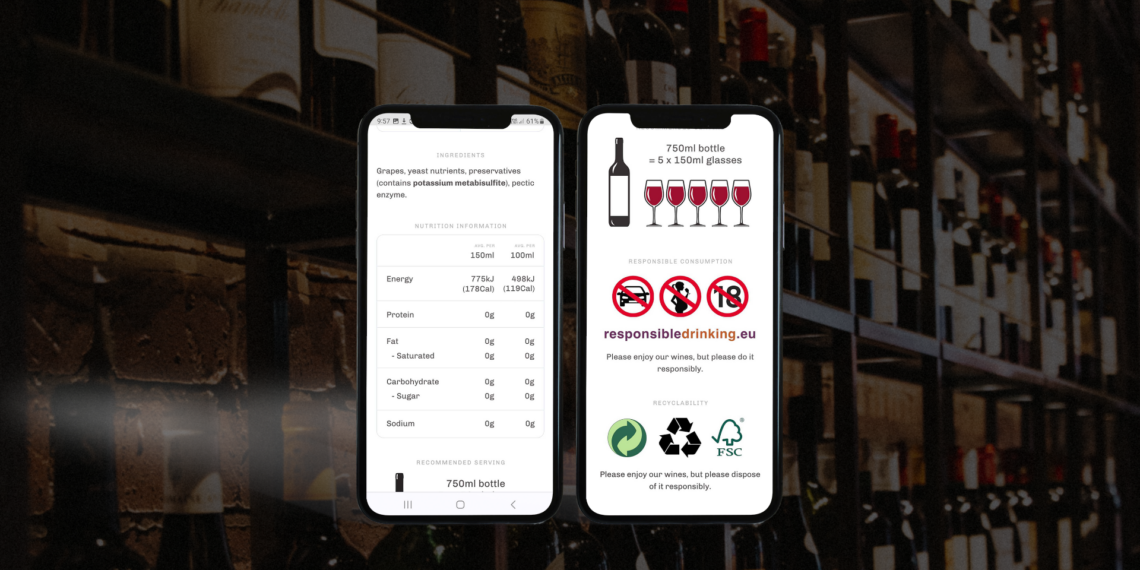From December 8, 2023, wine sold in the European Union (EU) will be required to declare ingredient, allergen and nutrition information. With limited label space and ever-changing mandatory requirements, how can wineries ensure they stay compliant?
2023 seems to be flying past, and before we know it, the wine industry will have two huge things on its minds, the annual rush of Christmas sales and the introduction of the latest label changes mandated by the European Union (EU). For those unaware, the EU has mandated that from December 8, 2023, all wines sold within the EU will need to declare ingredient and nutrition information on their labels. This regulation has caused panic across wineries, exporters, and industry professionals. In this article, we will explore the details of these new EU label regulations, explore their concerns, and provide strategies for wineries to successfully implement and comply with the mandate.
Understanding the New Regulations
Any wine products bottled and labelled from December 8, 2023, that will be sold within the EU, will need to include comprehensive ingredient and nutrition information on their wine labels. Aiming to enhance transparency and empower consumers, the new requirement will provide consumers with vital insights into the composition and nutritional aspects of the wines they purchase. However, introducing these regulations has raised concerns within the industry regarding the practicality of incorporating this information without overcrowding the labels and compromising design aesthetics.
Challenges for Wineries
The implementation of the new EU label regulations poses significant challenges for wineries. The main one is the limitation of label space, which is already dedicated to mandatory content, such as brand identity, appellation, and warning labels, which makes it difficult to accommodate additional information without overwhelming the design. In addition, complying with evolving compliance requirements adds to the complexity of keeping labels up to date with changing regulations. Wineries must navigate these challenges while ensuring their labels remain visually appealing and informative to consumers.
Introducing eLabels
To aid the issue of label overcrowding, limited packaging space, and evolving compliance, the new EU label legislation has approved eLabels to deliver ingredient and nutrition information on wine labels.
eLabels, short for electronic labels, are a digital alternative to physical printed labels, utilising connected technology such as QR codes to deliver dynamic product information to consumers. By scanning a QR code, eLabel, consumers can access a digital interface that displays a wide range of information about the product, including ingredients, nutritional values, allergens, manufacturing details, sustainability certifications, product history, and more.
What we know so far
The final draft of the legislation is yet to be published (expected July 2023), but here is what we know so far.
Physical and Digital: The new EU regulations for wine labelling require including energy value and allergenic ingredients on the physical label, with full nutrition and ingredient information allowed to be provided electronically via QR codes.
Language translation: The law requires making mandatory information appear in a language easily understood by consumers where the product is sold. It further states that E.U. member countries can specify the languages in which e-labels must be displayed.
Zero Marketing & Sales Content: So far, the legislation opposes dual-purpose eLabels, stating that electronic labels may only contain the required information, with zero sales or marketing content allowed.
No data collection: Along with ensuring GDPR compliance, EU-compliant eLabels are prohibited from collecting or tracking any user data.
Non-compliance implications: Non-compliant labels and E-labels will be subject to the removal of products in the EU & face potential fines. For reference, current and early GPDR fines can be in the hundreds of thousands and millions of Euros.
Positives of the eLabel Solution
With deadlines looming, the industry still has uncertainty regarding compliance with the EU label mandates, so including an eLabel for delivering the EU mandatory information is a welcome outcome. This allows winery production, sales and export teams to set up label artwork now, with the opportunity to change and update the eLabel content as more clarity is delivered.
In addition, wineries should look to the eLabel solution for;
- Automatic language translation – no need for label prints/over-stickers per region.
- Real-time updates and changes – Amend issues or errors after labels are printed.
- Reduce label over-crowding
- Geotargeted content – Deliver compliant content in the EU and sales and marketing content in non-EU regions.
Ensuring compliance
To ensure compliance with these evolving regulations, brands may need to utilise separate websites or digital platforms designed to meet the requirements. Traditional websites won’t be suitable due to their marketing and tracking functionalities. Still, connected software solutions, such as Cellr, can allow brands to leverage QR code eLabels, which provide full compliance.
Furthermore, by utilising an innovative, connected platform like Cellr, brands can stay compliant in EU markets, deliver features like brand protection, and even use geotargeting to provide sales and marketing content in markets external to the EU.
The EU legislation is yet to be finalised at the time of posting, but the draft regulations have created a sense of urgency within the wine industry. As wineries strive to stay compliant and provide transparent information to consumers, eLabels present a promising solution to overcome the challenges of limited label space and evolving requirements. By embracing digital technologies and leveraging specialized platforms, brands can navigate the regulatory landscape while delivering a seamless and engaging consumer experience.

